Bhubaneswar - Dhauli - Pipli - Konark – Puri - Mangalajodi - Gopalpur - Phulbani – Rayagada - Chatikona - Semiliguda - Onukudelli - Kunduli - Vishakapatnam
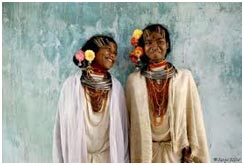 Odisha is uniquely proud for the tinted spread of ethnic mosaic brought over by the 62 culturally vibrant tribes including 13 primitive tribal groups, who are found sprinkled all over the state.Across the Eastern Ghats, lies the hinterland of Odisha, the home of ancient tribes-the Didayi and the Bondas of Koraput, the Kondhs of Kandhmal(formerly name Phulbani). Here beats Odisha’s primordial heart. The tribal people showcase a rainbow of oriental culture and cultural trappings, which are held beautiful in an ethnic kaleidoscope. It is belived that the original inhabitants of Odisha were such primitive tribes akin to the Saoros and Juangs, groups living in the wooded hinterland. Here, in the dense jungles, any ambiguous essence is symbolized and made into ritual objects. Discover it the same way the primeval tribes of Odisha have passed it down – through art, dance, myths, music and the land itself.
Odisha is uniquely proud for the tinted spread of ethnic mosaic brought over by the 62 culturally vibrant tribes including 13 primitive tribal groups, who are found sprinkled all over the state.Across the Eastern Ghats, lies the hinterland of Odisha, the home of ancient tribes-the Didayi and the Bondas of Koraput, the Kondhs of Kandhmal(formerly name Phulbani). Here beats Odisha’s primordial heart. The tribal people showcase a rainbow of oriental culture and cultural trappings, which are held beautiful in an ethnic kaleidoscope. It is belived that the original inhabitants of Odisha were such primitive tribes akin to the Saoros and Juangs, groups living in the wooded hinterland. Here, in the dense jungles, any ambiguous essence is symbolized and made into ritual objects. Discover it the same way the primeval tribes of Odisha have passed it down – through art, dance, myths, music and the land itself.
Welcome to Bhubaneswar – The Temple city of India. Meet and greet on arrival and transfer to Hotel. Being the seat of Tribhubaneswar or 'Lord Lingaraj', Bhubaneswar is an important Hindu pilgrimage centre. Hundreds of temples dot the landscape of the Old Town, which once boasted of more than 2000 temples. It is the temple city Bhubaneshwar that calls for attention, dotted as it is with temples — big, small, ancient and in clusters.
Overnight at Hotel- Bhubaneswar
After breakfast visit the Temple City of Bhubaneswar.
Among the finest of its 600 temples is the Lingaraj Temple of Shiva built in the 11th century, it is also the biggest in Bhubaneswar. The temple is dedicated to Lord Shiva, also known as ‘Lingaraj’. It is adorned with beautiful sculptures, which have been carved on the spire. Bindusagar Lake lying to the north of the Lingaraja Temple, is one of the popular tourist attractions of Bhubaneswar. Lingaraj Temple (Non Hindu are not allowed inside the temple. To be viewed from a platform outside) .
Mukteshwar Temple, is one of the most prominent temples of Bhubaneswar and has been constructed in the style that is quite similar to the one used in the Kalinga School of Temple Architecture. Rajarani Temple is one of the most renowned temples in Bhubaneswar, the capital city of Odisha. It is made from the wonderful red and gold sandstone, which is locally known as Rajarani and this is what gives the temple its name of ‘Raja Rani’.
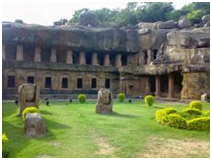
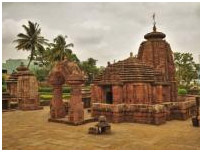

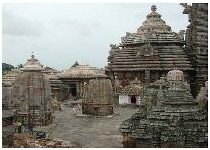 Afternoon visit the ancient caves of Khandagiri and Udaygiri which were carved and tunneled, to create this multi-storied ancient apartment residence for Jain monks. They were the work of the first known Odishan ruler, King Kharavela, and probably begun in the first century BC. Kharavela was a king of the Mahameghavahana dynasty, who is known for expansion of the Kalinga empire and his installation of public improvements, such as canal systems. His queen was evidently quite a patron of the arts, and probably had much to do with the impressive sculptural decoration of the caves.
Afternoon visit the ancient caves of Khandagiri and Udaygiri which were carved and tunneled, to create this multi-storied ancient apartment residence for Jain monks. They were the work of the first known Odishan ruler, King Kharavela, and probably begun in the first century BC. Kharavela was a king of the Mahameghavahana dynasty, who is known for expansion of the Kalinga empire and his installation of public improvements, such as canal systems. His queen was evidently quite a patron of the arts, and probably had much to do with the impressive sculptural decoration of the caves.
Overnight at Hotel- Bhubaneswar
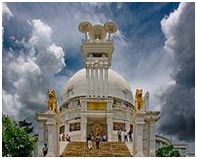 Day 3: Saturday, Bhubaneswar – Dhauli-Pipli - Konark – Puri – 120kms/3hrs
Day 3: Saturday, Bhubaneswar – Dhauli-Pipli - Konark – Puri – 120kms/3hrs
After breakfast leave for Puri enroute visiting Pipli appliqué village and Konark.
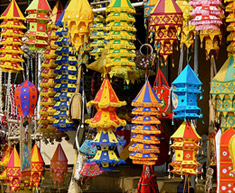 The Shanti Stupa at Dhauli Hills is a significant symbol of love and peace. The pilgrimage is significant because here King Ashoka resigned from violent wars. After witnessing the devastating sight of blood filled land and the Daya River that obtained red color because of the merciless slaughter of around 1,50, 000 warriors, King Ashoka was filled with sheer grief and therefore decided to renounce wars completely all through the rest of his life. It is at Dhauli that Ashoka resorted to Buddhism and presented his sword in front of Lord Buddha.
The Shanti Stupa at Dhauli Hills is a significant symbol of love and peace. The pilgrimage is significant because here King Ashoka resigned from violent wars. After witnessing the devastating sight of blood filled land and the Daya River that obtained red color because of the merciless slaughter of around 1,50, 000 warriors, King Ashoka was filled with sheer grief and therefore decided to renounce wars completely all through the rest of his life. It is at Dhauli that Ashoka resorted to Buddhism and presented his sword in front of Lord Buddha.
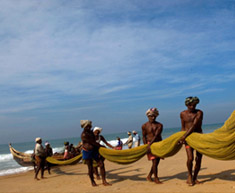 Pipli – It’sa centre for appliqué work, which depicts the essence of Oriya culture. It is also known for colorful and original awnings, canopies, garden and beach umbrellas, shoulder and handbags etc. The cocktail effect of the colors is certainly a feast for the eyes. Pipli, Odisha's appliqué capital, announces itself with loud colourful splashes of bright colour in the shop fronts.
Pipli – It’sa centre for appliqué work, which depicts the essence of Oriya culture. It is also known for colorful and original awnings, canopies, garden and beach umbrellas, shoulder and handbags etc. The cocktail effect of the colors is certainly a feast for the eyes. Pipli, Odisha's appliqué capital, announces itself with loud colourful splashes of bright colour in the shop fronts.
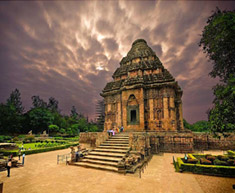 Konark - The third link in the Odishan Golden Triangle, Konark is the site of one of the most spectacular examples of religious architecture in the world. The Sun Temple at Konark conceived as a massive chariot hauling the Sun God across the heavens by the might of seven splendidly carved horses, standing aloft on 24 chariot wheels-intricately carved - symbolizing the march of time, lies in solitary splendor surrounded by drifting sand three kilometres from the sea, but originally it was reported to be closer for which it was used as a navigational point by European sailors, who referred to it as the 'Black Pagoda'. This 13th century architectural marvel is one of the most magnificent monuments of the World and also a UNESCO World Heritage site. Nobel Laureate & Poet Rabindranath Tagore said, 'here the language of stone surpasses the language of man'. It is true that the experience of Konark is impossible to translate into words. .
Konark - The third link in the Odishan Golden Triangle, Konark is the site of one of the most spectacular examples of religious architecture in the world. The Sun Temple at Konark conceived as a massive chariot hauling the Sun God across the heavens by the might of seven splendidly carved horses, standing aloft on 24 chariot wheels-intricately carved - symbolizing the march of time, lies in solitary splendor surrounded by drifting sand three kilometres from the sea, but originally it was reported to be closer for which it was used as a navigational point by European sailors, who referred to it as the 'Black Pagoda'. This 13th century architectural marvel is one of the most magnificent monuments of the World and also a UNESCO World Heritage site. Nobel Laureate & Poet Rabindranath Tagore said, 'here the language of stone surpasses the language of man'. It is true that the experience of Konark is impossible to translate into words. .
Also visit the local Fishermans village and interact with the local community.
Proceed to Puri. All hotels in Puri have check-in/check-out at 08:00 hrs
For centuries now, the beach at Puri has been the venue of countless pilgrims taking the traditional purifying dip. However, for decades now, both Indian and foreign beach lovers have made it their special haunt. The fine golden sands of Puri beach and the roar of the breakers rolling in from the Bay of Bengal have fascinated visitors throughout the ages. As it is with all the beaches of Odisha, overcrowding is never a problem and the sight of holiday-makers having entire stretch of the beach to themselves is not uncommon.The local fishermen, with their catamarans and wide brimmed cane hats are welcomed by tourists.
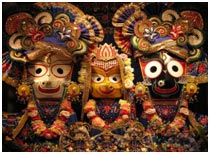 Later in the afternoon visit the Jagannath Temple at Puri which is one of the most sacred pilgrimage spots in India. This 12th century temple is dedicated to Lord Jagannath –“The Lord of the Universe”. The wooden figures of the three deities, Jagannath, Balabhadra and Subhadra stand in the sanctorium garlanded and decorated by the high priests. The extraordinary form that Jagannath takes, according to the legend, is the unfinished work of the craftsman god Viswakarma, who in anger left this portrayal of Lord Vishnu incomplete. This majestic temple and its chronicles allure devotees from all over the world. The wide BadaDanda, the road which leads up to the majestic temple, provides a view of the grandness of scale and proportion that typifies Puri. This is also the path to Nirvana, where the chariots of the much-loved divine siblings, Jagannath, Subhadra and Balabhadra, roll down in the famous annual Rath Yatra, which inspires awe and draws tumultuous crowds. In Puri, everything has to be big. The main road is called BadaDanda, or Grand Road; the sea is Mahodadhi, or the widest ocean; the bhog is called Mahaprasad, or the great prasad.
Later in the afternoon visit the Jagannath Temple at Puri which is one of the most sacred pilgrimage spots in India. This 12th century temple is dedicated to Lord Jagannath –“The Lord of the Universe”. The wooden figures of the three deities, Jagannath, Balabhadra and Subhadra stand in the sanctorium garlanded and decorated by the high priests. The extraordinary form that Jagannath takes, according to the legend, is the unfinished work of the craftsman god Viswakarma, who in anger left this portrayal of Lord Vishnu incomplete. This majestic temple and its chronicles allure devotees from all over the world. The wide BadaDanda, the road which leads up to the majestic temple, provides a view of the grandness of scale and proportion that typifies Puri. This is also the path to Nirvana, where the chariots of the much-loved divine siblings, Jagannath, Subhadra and Balabhadra, roll down in the famous annual Rath Yatra, which inspires awe and draws tumultuous crowds. In Puri, everything has to be big. The main road is called BadaDanda, or Grand Road; the sea is Mahodadhi, or the widest ocean; the bhog is called Mahaprasad, or the great prasad.
(Non Hindus are not allowed inside the Jagannath temple and to be viewed from Raghunathan library platform. Sunday this platform is closed but one can view from another platform outside the temple.)
Overnight at Hotel- Puri.
 Day 4: Sunday, Puri – Mangalajodi-Gopalpur-On-Sea -185kms/3.5 hrs
Day 4: Sunday, Puri – Mangalajodi-Gopalpur-On-Sea -185kms/3.5 hrs
After breakfast drive to Gopalpur-on-Sea enroute visiting Raghurajpur and Olasingh – a small weaving village
The big attraction at Raghurajpur is that the whole village community is involved in making some kind of handicraft. Many have even won national awards for their work. There are just over 100 households and 300 artisans in the village. You can wander around, check out the beautiful painted murals on the houses, chat to the friendly artisans and see them in action -- and of course shop! Pattachitra traditional cloth paintings are a specialty in the village, but the artisans make a wide variety of items including palm leaf engravings, stone carvings, wood carvings, and wooden toys.
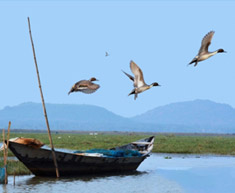 Mangalajodi, Chilka Lake- A vast lake along the eastern cost of Odisha with beautiful islands, flamingoes wading in the shallow waters and the air echoing with the chirping of birds from as far as the Caspian Sea, Aral Sea and other parts of Mongolia, Central and South-East Asia, that’s the breath-taking beauty of Chilika-Asia’s largest brackish water estuarine lake. Chilika sprawls over an area of 1100 sq.km covering parts of three districts of Odisha i.e. Puri on the east, Khurdha on the North and Ganjam on the South. It’s a haven for bird-watchers / nature lovers. Abounding in unique flora and fauna, Chilika supports the livelihood of more than hundred thousand families living in and around it. Winter is the best time to visit Chilika as over 160 species of migratory birds flock the islands during this time of the year.
Mangalajodi, Chilka Lake- A vast lake along the eastern cost of Odisha with beautiful islands, flamingoes wading in the shallow waters and the air echoing with the chirping of birds from as far as the Caspian Sea, Aral Sea and other parts of Mongolia, Central and South-East Asia, that’s the breath-taking beauty of Chilika-Asia’s largest brackish water estuarine lake. Chilika sprawls over an area of 1100 sq.km covering parts of three districts of Odisha i.e. Puri on the east, Khurdha on the North and Ganjam on the South. It’s a haven for bird-watchers / nature lovers. Abounding in unique flora and fauna, Chilika supports the livelihood of more than hundred thousand families living in and around it. Winter is the best time to visit Chilika as over 160 species of migratory birds flock the islands during this time of the year.
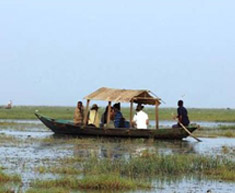 A community owned and managed wildlife conservation venture, Mangalajodi Ecotourism is your destination to get a peep into Mother Nature. Mangalajodi is a village located on the northern banks of Chilika Lake in Odisha, ‘The Bird’s Paradise’ hosts more than 3,00,000 birds in its marshy waters, especially in winters. Mangalajodi also represents one of its kind ecosystems, whose protection is epitomised by a sustainable lifestyle that is at a brink of extinction in urban settings.
A community owned and managed wildlife conservation venture, Mangalajodi Ecotourism is your destination to get a peep into Mother Nature. Mangalajodi is a village located on the northern banks of Chilika Lake in Odisha, ‘The Bird’s Paradise’ hosts more than 3,00,000 birds in its marshy waters, especially in winters. Mangalajodi also represents one of its kind ecosystems, whose protection is epitomised by a sustainable lifestyle that is at a brink of extinction in urban settings.
Enjoy a country boat ride at Mangalajodi .Also visit the Mangalajodi village and interact with the fishing families.
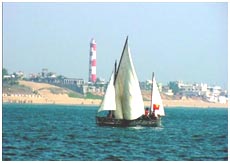 Gopalpur – On-Sea which is a sleepy hamlet that betrays no traces of its glorious past. The ruins of an old port speak of a time that won Gopalpur its prominent place in Odisha’s history. You can forget yourself at Gopalpur and have a lovely, lazy holiday. This virgin beach with coconut groves, casuarina coppices and gentle sand dunes is deserted for miles and perfect for an ultimate relaxation to prepare you for your adventurous tribal trail ahead.
Gopalpur – On-Sea which is a sleepy hamlet that betrays no traces of its glorious past. The ruins of an old port speak of a time that won Gopalpur its prominent place in Odisha’s history. You can forget yourself at Gopalpur and have a lovely, lazy holiday. This virgin beach with coconut groves, casuarina coppices and gentle sand dunes is deserted for miles and perfect for an ultimate relaxation to prepare you for your adventurous tribal trail ahead.
Overnight at Hotel – Gopalpur-On-Sea.
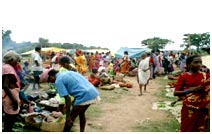 Day 5: Monday, Gopalpur-On-Sea– Phulbani - 180 kms/4.5hrs
Day 5: Monday, Gopalpur-On-Sea– Phulbani - 180 kms/4.5hrs
After breakfast, drive to Phulbani enroute visiting traditional Orissan villages and local market + village temples etc. Phulbani: The district head quarter of Kandhmal is a place to relax in and marvel at the natural beauty surrounded by hills and the Pillasalunki river that flows on its three side.
Overnight at Hotel-Phulbani.
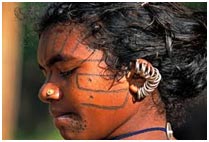 Day 6: Tuesday, Phulbani – Rayagada - 280 km / 5.5 hrs. Must be a Tuesday
Day 6: Tuesday, Phulbani – Rayagada - 280 km / 5.5 hrs. Must be a Tuesday
After breakfast, drive to Rayagada enroute visiting weekly tribal market at Kotgarh of KutiaKondh tribe and nearby traditional villages.
Rayagada is a district of meadows, forests, waterfalls and terraced valleys, thickly inhabited by colourful ethnic and tribal groups. The scenic beauty and heritage on the land is an unexplored paradise. The systematic relationship between men and nature is a feast to the eyes of an outsider. A district of many charms, it is a thrill to the searching eyes with its own appeal.
The Kondh Tribe- The Kondhs are one of the well known tribes of Orissa who were famous in history for their Meriah –Human Sacrifice.They are found almost in all the districts of Orissa but mostly concentrated in large numbers in Phulbani,Koraput and Ganjamdistricts.Kondh’s life is full of festivities. The important festivals are at the time of sowing and harvesting.Duringfestivals,feast is accompanied by singing,dancing and drinking.At the time of sowing seeds they worship Dharani Deota and make animal sacrifice to ensure good crop. The village women sing and dance joining hands and the boys standing around also sing and the entire atmosphere becomes joyous. During Sarupenu festival they resort to worship on the hills and enjoy the day with feasting and dancing. Their weapon is bow and arrow by which they defend themselves from wild animals.The most important aspect of tribal culture is the music and dance.
Overnight at Hotel-Rayagada
Breakfast at Hotel.
Rayagada is a district of meadows, forests, waterfalls and terraced valleys, thickly inhabited by colourful ethnic and tribal groups. The scenic beauty and heritage on the land is an unexplored paradise. The systematic relationship between men and nature is a feast to the eyes of an outsider. A district of many charms, it is a thrill to the searching eyes with its own appeal.
Visit their markets locally called ‘haat’ and make your way through the swarm of buyers and sellers, buy fresh produce and enjoy a traditional local cuisine experience. Visit the Kondh tribal community which were once famous in history for their Meriah-Human Sacrifice. Explore their lifestyle and the varied handicraft villages. Swing to the rhythmic moods of the tribal people who enjoy their lives through dance and music. Tribal villages often vibrate with drumbeats and hills echo with resonance of music. The waterfalls, springs, hills and forests come to life with the rhythmic musical moods almost every day.
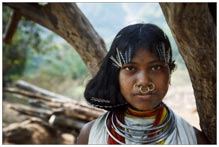 Visit the weekly Wednesday market of the DongriyaKondhas at Chatikona - Here the DongariyaKondhas trek down from their villages up the Hill with forest produce to sell or barter with non-tribals. DongariyaKondhas are one of the original ethnic tribal groups of Odisha who have retained their culture and tradition till date. The Dongria family is often nuclear, although extended families are found. Female family members are considered assets because of their contribution inside and outside the household and women are on equal footing with the male members in constructing a house to cultivation. Women do all the work for household ranging from fetching water from the distant streams, cooking, serving food to each member of the household to cultivating, harvesting and marketing of produce in the market. Due to this, the bride price is paid to her parents when she gets married which is a striking feature of the Dongrias.
Visit the weekly Wednesday market of the DongriyaKondhas at Chatikona - Here the DongariyaKondhas trek down from their villages up the Hill with forest produce to sell or barter with non-tribals. DongariyaKondhas are one of the original ethnic tribal groups of Odisha who have retained their culture and tradition till date. The Dongria family is often nuclear, although extended families are found. Female family members are considered assets because of their contribution inside and outside the household and women are on equal footing with the male members in constructing a house to cultivation. Women do all the work for household ranging from fetching water from the distant streams, cooking, serving food to each member of the household to cultivating, harvesting and marketing of produce in the market. Due to this, the bride price is paid to her parents when she gets married which is a striking feature of the Dongrias.
After visit proceed to Semiliguda.
Overnight at Hotel - Semiliguda.
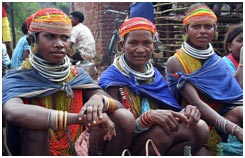 Day 8: Thursday, Semiliguda - Onukudelli – Semiliguda - Must be a Thursday- 165 kms / 3.5 hrs
Day 8: Thursday, Semiliguda - Onukudelli – Semiliguda - Must be a Thursday- 165 kms / 3.5 hrs
After breakfast visit the weekly Thursday market of the Bondas at Onkudelli. Nature has showered its bounty on the undivided Koraput district replete with meadows, forests, waterfalls, terraced valleys and darting springs. This land of abundance is home to Odisha's vast tribal population. A real paradise for the nature-lover, Jeypore offers an additional benefit to the visitor of first hand meeting with its ancient civilization.
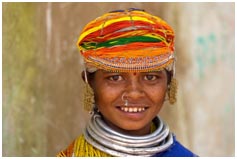 Today visit the home of the approximately 6000 members of the famed Bonda Tribes–one of the most fascinating tribes of the Country. They live in the remote hills and keep themselves isolated. They grow rice by shifting cultivation and keep domesticated cows and goats. They can only be seen when they come to trade at the local weekly Thursday market. The Bonda women are noticeable by the chunks of beaded necklaces that cover their upper body , striking brass and silver necklace and their shaved heads decorated with colourful beads.
Today visit the home of the approximately 6000 members of the famed Bonda Tribes–one of the most fascinating tribes of the Country. They live in the remote hills and keep themselves isolated. They grow rice by shifting cultivation and keep domesticated cows and goats. They can only be seen when they come to trade at the local weekly Thursday market. The Bonda women are noticeable by the chunks of beaded necklaces that cover their upper body , striking brass and silver necklace and their shaved heads decorated with colourful beads.
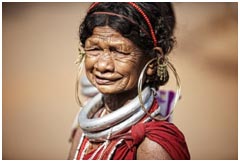 In Bonda society, the women enjoy a privileged position. They are the primary workers and providers of food for the community. Bonda girls largely marry boys who are at least five to ten years younger than them. Thus the girl looks after her husband as he grows up and in turn he cares for his elder wife. In contrast with many other populations in India, the number of women among the Bondas greatly exceeds the number of men.
In Bonda society, the women enjoy a privileged position. They are the primary workers and providers of food for the community. Bonda girls largely marry boys who are at least five to ten years younger than them. Thus the girl looks after her husband as he grows up and in turn he cares for his elder wife. In contrast with many other populations in India, the number of women among the Bondas greatly exceeds the number of men.
Visit another ethnic tribal group of the Gadabbas. Both men and women tie their long hairs with linseed oil and decorate it with forestry flowers and different ornaments. The women wear a long strip of cloth tied around the waist and a second piece of cloth is worn across the breasts and tied over one shoulder.
Overnight at Hotel - Semiliguda
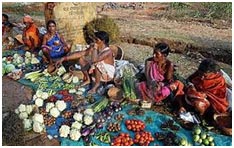 Day 9: Friday, Semiliguda – Kunduli - Vishakapatnam - Must be a Friday – 235 kms/5.5hrs
Day 9: Friday, Semiliguda – Kunduli - Vishakapatnam - Must be a Friday – 235 kms/5.5hrs
After breakfast visit another interesting Paraja tribe assembles at Kunduli every Friday.
The Parajas are divided into different sub-groups viz., Sodia, Jadia and Parenga; each of them seems to be a separate ethnic group. The Parajas have a number of totemistic septs like Bagh-tiger, Bokda-goat, Netam-Dog, Pandki-Dove, and the like, and harming or eating the totem animal is forbidden. Instead such animals should be respected. They also worship various gods and goddesses residing in hills or forests. Also visit the Koraput Jagannath temple where Non-Hindus are also permitted unlike in Puri and Tribal Museum.
Later we proceed to Vishakhapatnam and so ends our tryst with the fascinating tribals who leave behind a smile to beckon you!
As you drive past the last scenic stretch of Odisha you subconsciously dwell and try to ascertain the life of a tribal who inspite of being diametrically opposite to the urban man is more adept in upholding the ethos of society by protecting Mother Nature and its bounty. The sheer prominence of women and the tremendous respect they garner in their community is a right they are entitled to and not one to be struggled for as in the Cosmopolis city.
Arrive into Vishakhapatnam
Vishakhapatnam - The crest of natural beauty of Andhra Pradesh. Located in the north of the coastal part of the State, the district and surrounding areas have some of the most fascinating places that one would love to visit.Vishakapatnam, originally a small fishing village, is one of the biggest ports in the country housed in a natural harbour with a picturesque hill resembling a dolphin, aptly named Dolphin’s nose, forming the recess.
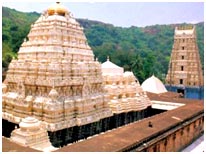 Simhachalam Temple - The hill of the lion is located at a distance of 18 km from Vishakapatanam refers to the 11th century temple of Lord Narasimha - an incarnation of Vishnu. Millions of devotees from round the world visit this temple every year. The presiding deity here is VarahaLakshminarasimha, combining the iconographic features of Varaha and Narasimha. The image resembles a Shivalingam covered with sandal paste. It is only once a year, during the ChandanaVisarjana that the sandal paste is removed, and the image is seen by pilgrims. The artwork here has elements of similarity with that of Konark. Elephants, flowers and plants are portrayed in plenty. The outer walls of the sanctum depict images of a royal personality (said to be King Narasimha) in various postures. The KalyanaMandapa within the temple has 16 pillars with bas relief depicting the incarnations of Vishnu.
Simhachalam Temple - The hill of the lion is located at a distance of 18 km from Vishakapatanam refers to the 11th century temple of Lord Narasimha - an incarnation of Vishnu. Millions of devotees from round the world visit this temple every year. The presiding deity here is VarahaLakshminarasimha, combining the iconographic features of Varaha and Narasimha. The image resembles a Shivalingam covered with sandal paste. It is only once a year, during the ChandanaVisarjana that the sandal paste is removed, and the image is seen by pilgrims. The artwork here has elements of similarity with that of Konark. Elephants, flowers and plants are portrayed in plenty. The outer walls of the sanctum depict images of a royal personality (said to be King Narasimha) in various postures. The KalyanaMandapa within the temple has 16 pillars with bas relief depicting the incarnations of Vishnu.
Overnight at Hotel - Vishakhapatnam.
Today after breakfast proceed to Vishakhapatnam airport for departure with lots of memories to cherish for a life time!
This is the end of the Trip!
Happy Memories!
